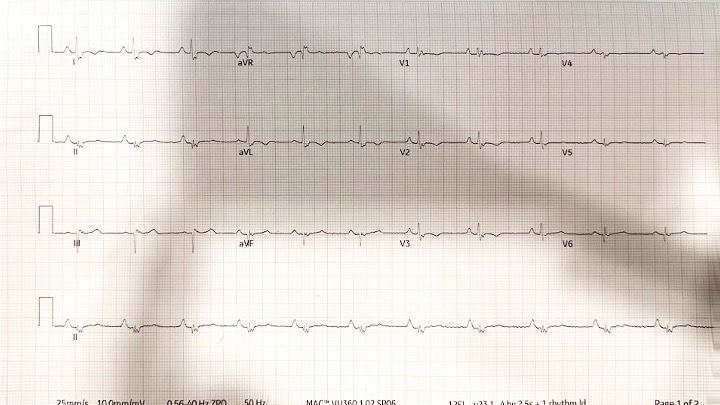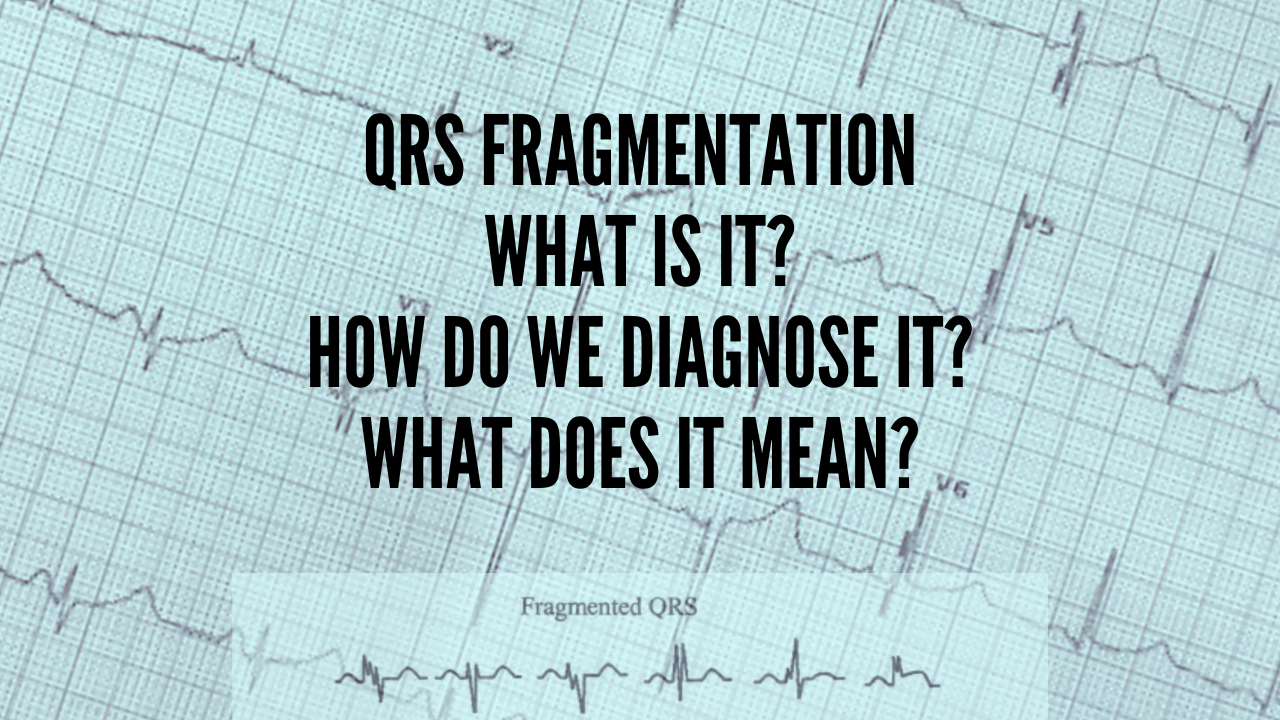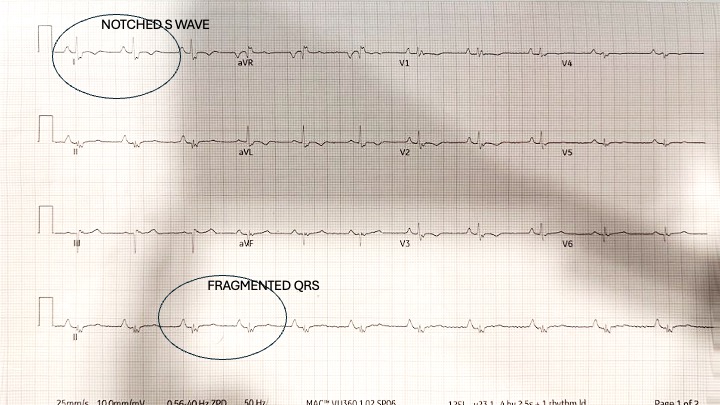A patient is brought to the emergency department with a complaint of central pressing chest pain.
The patient’s ecg is shown below.
Is this QRS fragmentation (QRSF) and what does that mean?

It has been suggested that alterations in the QRS morphology can occur with myocardial scarring following myocardial infarction. This scarring may lead to a fragmentation of the QRS complex in the ecg.
Why might this be important? The sensitivity of a Q wave for previous MI is low and Q waves may regress in over 50% of cases.
Definition of QRS fragmentation
The presence of additional R’ or a notch in the nadir of the R or S wave in two contiguous leads in one coronary territory in a routine 12-lead ECG(1). A fragmented wide QRS is defined as two or more notches at least 40 ms apart, in the R or S wave, in two contiguous leads corresponding to a coronary territory.
Some examples are shown below
 ref (2)
ref (2)
 ref (2)
ref (2)
 ref (2)
ref (2)

Fragmented QRS (3)
The Significance or QRS fragmentation
The presence of QRSF without typical bundle branch block demonstrates MI in patients with CAD.
Anterior lead QRSF is associated with a higher incidence of multilevel disease and a greater severity of CAD(4). QRSF is common in inferior leads and without known cardiac disease does not predict an adverse cardiac outcome. Lateral lead QRSF has a higher risk of all-cause mortality(5).
Fragmentation is important as it has a higher sensitivity for prior MI than a Q wave (6). It is associated with a myocardial scar and predicts increased risk of morbidity and mortality.
The presence of QRSF:
- may predict the presence of left ventricular thrombus (7)
- may predict the presence of left ventricular aneurysm (sens 50% spec 94.6%) (8)
- may predict increased mortality risk in patient with heart failure (9,10)
- may predict the risk of ventricular arrhythmias in patients with hypertrophic cardiomyopathy (11)
- may predict the risk of death or ventricular arrhythmias in patients with Brugada (12)
- may predict the risk of idiopathic ventricular fibrillation (12)
If we look at the ecg shown above we see that there is QRSF.
References
- Jain R, et al. Fragmented ECG as a risk marker in cardiovascular diseases. Curr Cardiol Rev 2014 Aug;10(3):277e86.
- MIthilesh K Das et al. Significance of Fragmented QRS complex Versus a Q Wave in Patients with Coronary Artery Disease. Circulation. 2006;113: 2495-2501.
- Supreeth R.N et al. Fragmented QRS – Its significance. Ind Pacing and Electrophys Journal 20 (2020) 27e32
- Eyuboglu M, et al. Comparison of the presence of fragmented QRS complexes in the inferior versus the anterior leads for predicting coronary artery disease severity. Rev Port Cardiol 2017 Feb;36(2): 89e93.
- Terho HK, et al. Prevalence and prognostic significance of fragmented QRScomplex in middle-aged subjects with and without clinical or electrocardiographic evidence of cardiac disease. Am J Cardiol 2014 Jul 1;114(1):141e7.
- Das MK, et al. Significance of a fragmented QRS complex versus a Q wave in patients with coronary artery disease. Circulation 2006;113:2495e501.
- Baysal E, et al. Relationship between fragmented QRS complexes in leads V4-V6 and left ventricular apical thrombus formation in patients presenting with first acute anterior myocardial infarction. Turk Kardiyol Dernegi Arsivi 2017 Apr;45(3): 219e26.
- Reddy CV, et al. Fragmented left sided QRS in absence of bundle branch block: sign of left ventricular aneurysm. Ann Noninvasive Electrocardiol 2006 Apr;11(2):132e8
- Kanitsoraphan C, et al. Baseline fragmented QRS is associated with increased all-cause mortality in heart failure with reduced ejection fraction: a systematic review and meta- analysis. Ann Noninvasive Electrocardiol 2019 Mar;24(2):e12597.
- Torigoe K, et al. The number of leads with fragmented QRS is independently associated with cardiac death or hospitalization for heart failure in patients with prior myocardial infarction. J Cardiol 2012 Jan;59(1):36e41.
- Kang KW, et al. Fragmented QRS as a candidate marker for high-risk assessment in hypertrophic cardiomy- opathy. Heart Rhythm 2014 Aug;11(8):1433e40.
- Canpolat U, et al. Fragmented QRS complex predicts the arrhythmic events in patients with arrhythmogenic right ventricular cardio- myopathy/dysplasia. J Cardiovasc Electrophysiol 2013 Nov;24(11):1260e6.
- Wang J, et al. Idiopathic ventricular fibrillation with fragmented QRS com- plex and J wave in resting electrocardiogram. J Geriatr Cardiol 2012 Jun;9(2): 143e7.
(10 minutes reading time)











